Abstract
Five hundred and sixty British coalminers with relatively high or relatively low exposures to oxides of nitrogen, based on measurements of concentrations of these gases at nine collieries over four years, and records of the men's places of work and colliery mining conditions over a total of eight years have been studied. Data on these men's respiratory symptoms and ventilatory capacity (FEV1), obtained as part of an epidemiological study of British coalminers, have been used to investigate possible adverse effects of exposure to oxides of nitrogen. Exposures to oxides of nitrogen were generally well below threshold limit values, though occasional peaks after shotfiring and during diesel locomotive use did exceed short term limits. No relationship was found between exposure and respiratory symptoms or decline in FEV1 nor was there any evidence of differences in symptoms of FEV1 between 44 pairs of men matched for age, dust exposure, smoking habit, coal rank, and type of work, but differing in respect of exposure to oxides of nitrogen. It has not been possible to detect any adverse effects on the health of this working population of the levels of nitrogen oxides that have occurred in British mines over the past decade. With the current levels of these gases, any long term effects on respiratory health are so small as to be undetectable in the presence of smoking and dust exposure.
Full text
PDF
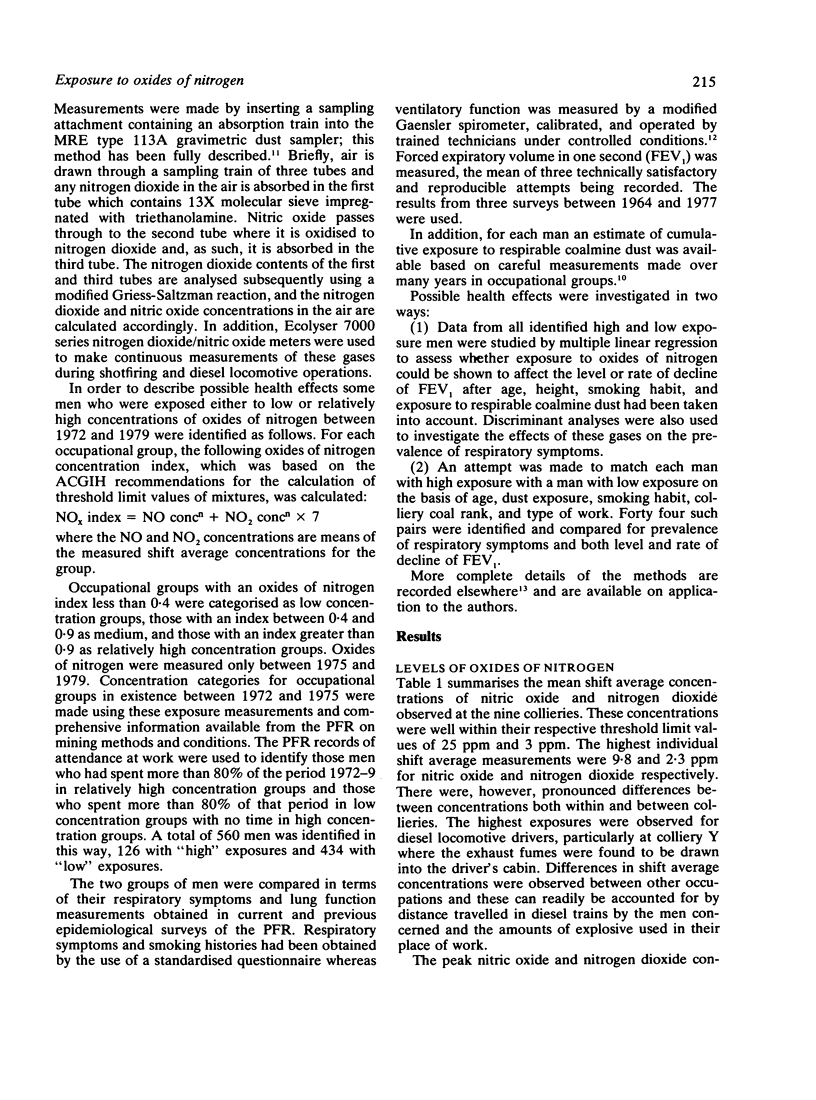
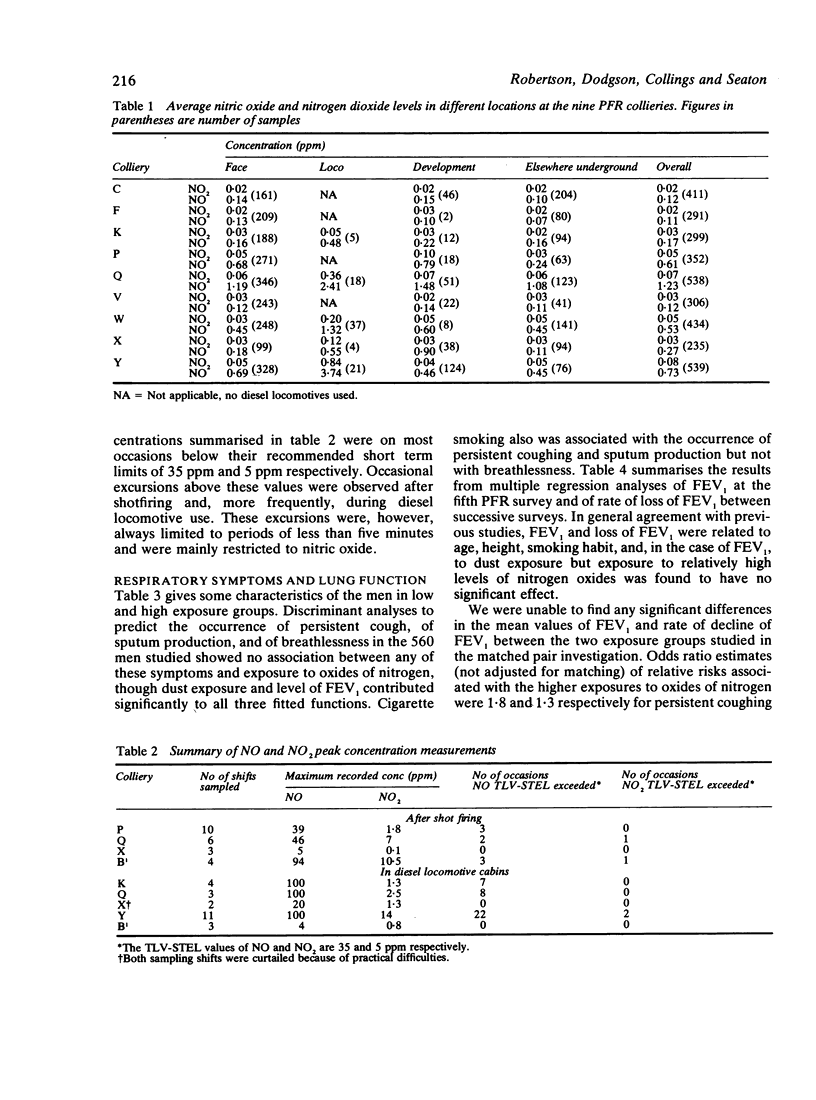
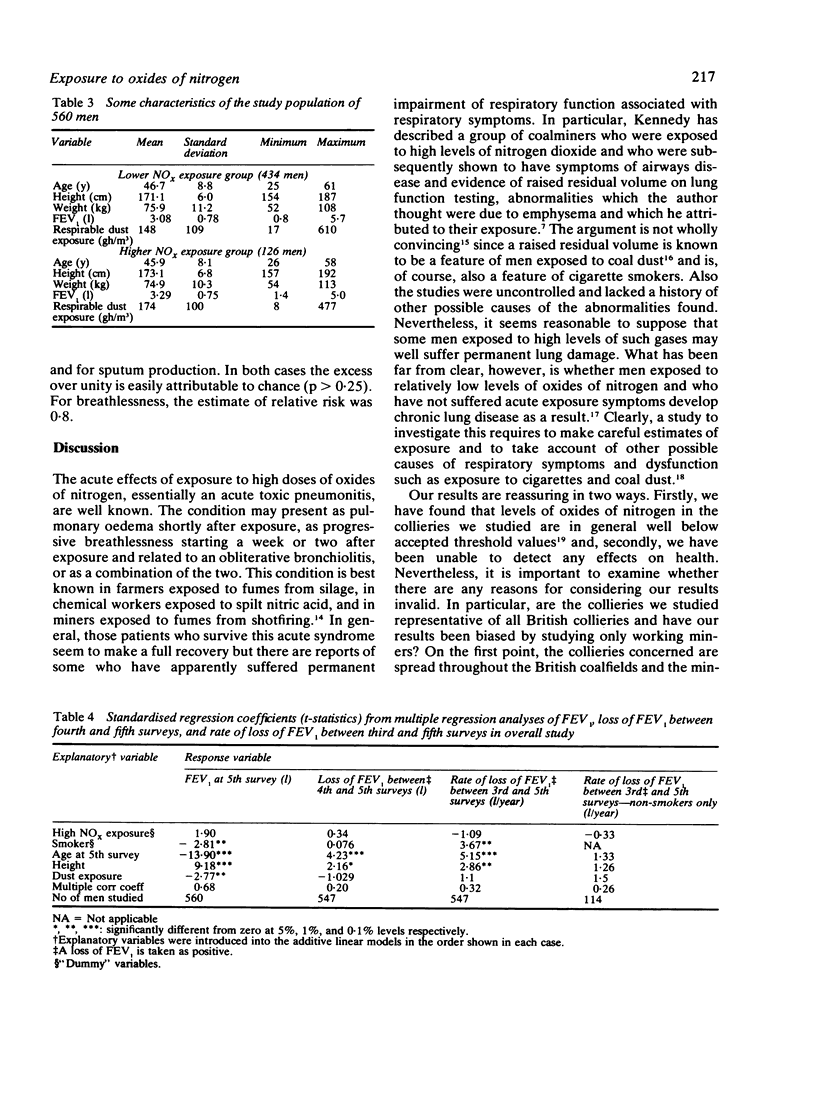
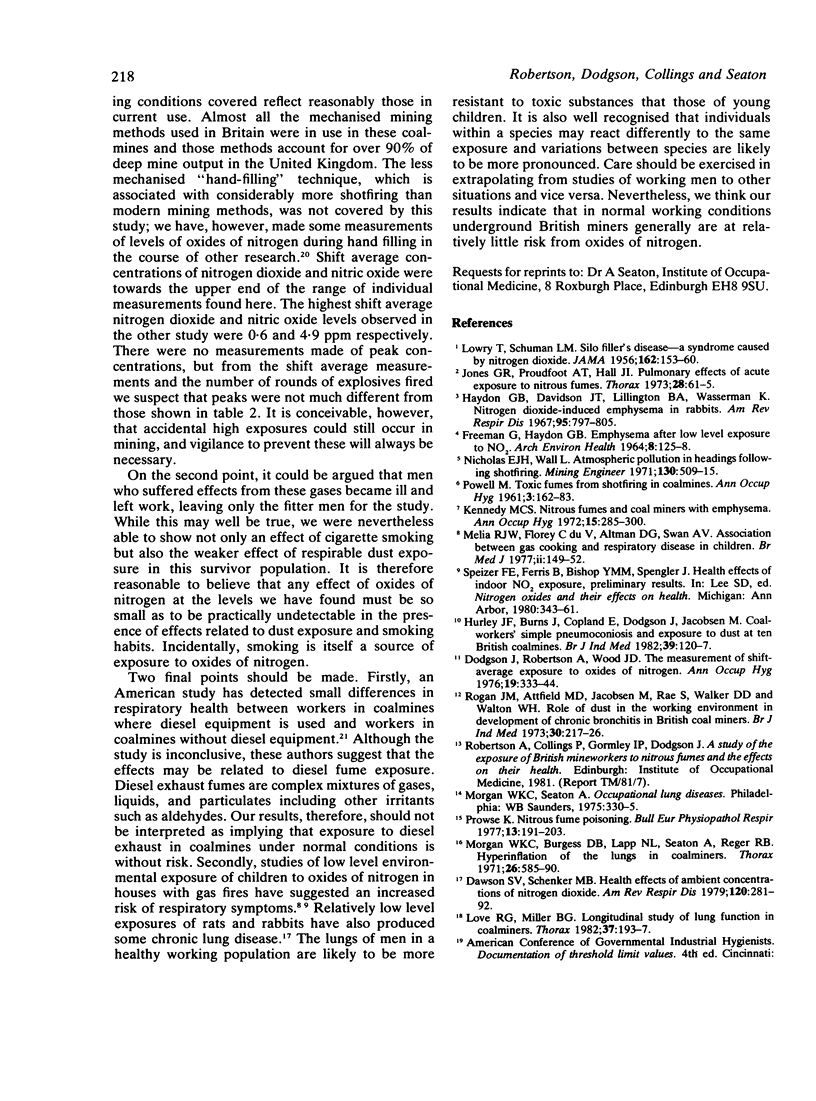
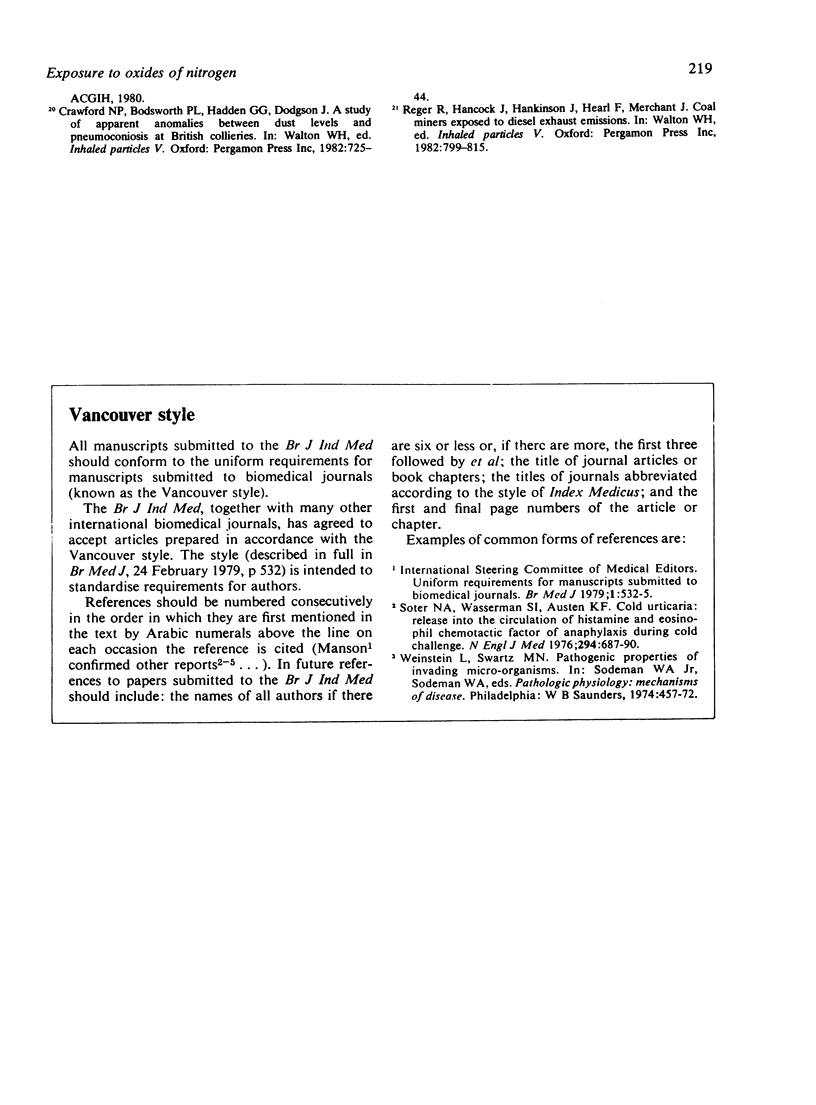
Selected References
These references are in PubMed. This may not be the complete list of references from this article.
- Crawford N. P., Bodsworth P. L., Hadden G. G., Dodgson J. A study of apparent anomalies between dust levels and pneumoconiosis at British collieries. Ann Occup Hyg. 1982;26(1-4):725–744. [PubMed] [Google Scholar]
- Dawson S. V., Schenker M. B. Health effects of inhalation of ambient concentrations of nitrogen dioxide. Am Rev Respir Dis. 1979 Aug;120(2):281–292. doi: 10.1164/arrd.1979.120.2.281. [DOI] [PubMed] [Google Scholar]
- Dodgson J., Robertson A., Wood J. D. The measurement of shift average exposures to oxides of nitrogen. Ann Occup Hyg. 1976 Dec;19(3-4):333–344. doi: 10.1093/annhyg/19.3-4.333. [DOI] [PubMed] [Google Scholar]
- FREEMAN G., HAYDON G. B. EMPHYSEMA AFTER LOW-LEVEL EXPOSURE TO NO2. Arch Environ Health. 1964 Jan;8:125–128. doi: 10.1080/00039896.1964.10663640. [DOI] [PubMed] [Google Scholar]
- Haydon G. B., Davidson J. T., Lillington G. A., Wasserman K. Nitrogen dioxide-induced emphysema in rabbits. Am Rev Respir Dis. 1967 May;95(5):797–805. doi: 10.1164/arrd.1967.95.5.797. [DOI] [PubMed] [Google Scholar]
- Hurley J. F., Burns J., Copland L., Dodgson J., Jacobsen M. Coalworkers' simple pneumoconiosis and exposure to dust at 10 British coalmines. Br J Ind Med. 1982 May;39(2):120–127. doi: 10.1136/oem.39.2.120. [DOI] [PMC free article] [PubMed] [Google Scholar]
- Jones G. R., Proudfoot A. T., Hall J. I. Pulmonary effects of acute exposure to nitrous fumes. Thorax. 1973 Jan;28(1):61–65. doi: 10.1136/thx.28.1.61. [DOI] [PMC free article] [PubMed] [Google Scholar]
- Kennedy M. C. Nitrous fumes and coal-miners with emphysema. Ann Occup Hyg. 1972 Nov;15(2):285–301. doi: 10.1093/annhyg/15.2-4.285. [DOI] [PubMed] [Google Scholar]
- LOWRY T., SCHUMAN L. M. Silo-filler's disease; a syndrome caused by nitrogen dioxide. J Am Med Assoc. 1956 Sep 15;162(3):153–160. doi: 10.1001/jama.1956.02970200001001. [DOI] [PubMed] [Google Scholar]
- Love R. G., Miller B. G. Longitudinal study of lung function in coal-miners. Thorax. 1982 Mar;37(3):193–197. doi: 10.1136/thx.37.3.193. [DOI] [PMC free article] [PubMed] [Google Scholar]
- Melia R. J., Florey C. D., Altman D. G., Swan A. V. Association between gas cooking and respiratory disease in children. Br Med J. 1977 Jul 16;2(6080):149–152. doi: 10.1136/bmj.2.6080.149. [DOI] [PMC free article] [PubMed] [Google Scholar]
- Morgan W. K., Burgess D. B., Lapp N. L., Seaton A. Hyperinflation of the lungs in coal miners. Thorax. 1971 Sep;26(5):585–590. doi: 10.1136/thx.26.5.585. [DOI] [PMC free article] [PubMed] [Google Scholar]
- POWELL M. Toxic fumes from shotfiring in coal mines. Ann Occup Hyg. 1961 May;3:162–183. [PubMed] [Google Scholar]
- Prowse K. Nitrous fume poisoning. Bull Eur Physiopathol Respir. 1977 Jan-Feb;13(1):191–203. [PubMed] [Google Scholar]
- Reger R., Hancock J., Hankinson J., Hearl F., Merchant J. Coal miners exposed to diesel exhaust emissions. Ann Occup Hyg. 1982;26(1-4):799–815. [PubMed] [Google Scholar]
- Rogan J. M., Attfield M. D., Jacobsen M., Rae S., Walker D. D., Walton W. H. Role of dust in the working environment in development of chronic bronchitis in British coal miners. Br J Ind Med. 1973 Jul;30(3):217–226. doi: 10.1136/oem.30.3.217. [DOI] [PMC free article] [PubMed] [Google Scholar]
- Soter N. A., Wasserman S. I., Austen K. F. Cold urticaria: release into the circulation of histamine and eosinophil chemotactic factor of anaphylaxis during cold challenge. N Engl J Med. 1976 Mar 25;294(13):687–690. doi: 10.1056/NEJM197603252941302. [DOI] [PubMed] [Google Scholar]


